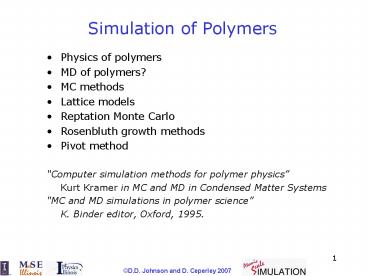Simulation of Polymers - PowerPoint PPT Presentation
1 / 11
Title:
Simulation of Polymers
Description:
Reptation Monte Carlo. Rosenbluth growth methods. Pivot method ' ... Polymer Reptation (slithering snake) CLAMPS has a SNAKE driver ... – PowerPoint PPT presentation
Number of Views:458
Avg rating:3.0/5.0
Title: Simulation of Polymers
1
Simulation of Polymers
- Physics of polymers
- MD of polymers?
- MC methods
- Lattice models
- Reptation Monte Carlo
- Rosenbluth growth methods
- Pivot method
- Computer simulation methods for polymer physics
- Kurt Kramer in MC and MD in Condensed Matter
Systems - MC and MD simulations in polymer science
- K. Binder editor, Oxford, 1995.
2
Time estimate for MD
- Time scales
- Local oscillations are 10-13 s so time step is
10-14 s - Important motions in polymers take seconds or
hours (real time) requiring 1014 to 1018 steps! - A system of 100 chains of 50 monomers (20,000
particles) takes about 1step/sec for 10-4 s (real
time) would take about 1010 secs or 300 years! - Distance scales
- Local effects are order 1A.
- Volume of cell is (100A)3.
- Solvent is important. Hydrodynamic effects
dominate. - Conclusion You need to make a simplified model
of the polymer to do research in this area.
3
Polymer Hamiltonian
- Self-avoiding random walk. (SAW)
- Consider a simple lattice and take a random walk
on the lattice--one which only visit each site
once. - Bead spring model
- Bonding interaction holds the chain together. Key
feature of polymer. A bead does not represent an
atom, but a blob--a section of the chain. - Non-bonded excluded volume interaction (LJ)
4
Polymer Phases
- For a repulsive interaction--the chains stretch
out, swell. - Characterize size by mean square end-end
distance. - lt(rn-r0)2gt ? N2?
- ? 0.588 SAW or 0.5 RW.
- This means MD will be very slow. Relaxation time
N2.2. - As attractive interaction are added in
- at some point the polymers collapse. (Theta
point collapse.) - Right at collapse point--walks are uncorrelated
random walks. - This is a type of phase transition.
- Big question how does the dynamics scale with
the length - of the chain-entanglement?
- Other topologies for polymers linear, rings,
stars,
5
Fermi- Pasta- Ulam experiment (1954)
- 1-D anharmonic chain V ?(q i1-q i)2? (q
i1-q i)3 - The system was started out with energy with the
lowest energy mode. Equipartition would imply
that the energy would flow into the other modes. - Systems at low temperatures never come into
equilibrium. - Energy sloshes back and forth between various
modes forever. - At higher T many-dimensional systems become
ergodic. - Beware this can happen with isolated polymers.
6
- 20K steps
- 400K steps
- Energy SLOWLY oscillates from mode to mode--never
coming to equilibrium
7
Polymer Reptation (slithering snake) CLAMPS has a
SNAKE driver
- Polymers move very slowly because of
entanglement. - Local MC just as slow as MD.
- A good algorithm is reptation.
- Cut off one end and stick onto the other end.
- Choose end at random or bounce with rejection.
- Sample directly the bonding interaction
- Acceptance probability is change in non-bonding
potential. - Simple moves go quickly through polymer space.
- But Ergodic? Not always (what if both ends get
trapped?) - Decorrelation time is O(N2). Works for many
chains. - Completely unphysical dynamics or is it?
- This may be how entangled polymers actually move.
(theory of Degennes)
8
Pivot algorithm
- Take a polymer. Pick an atom at random.
- Rotate one segment with respect to the pivot
point a random angle ?. - Accept or reject.
- Most efficient method for a single chain.
Exponent of relaxation of end-end distance is N0.2
9
Lattice model for polymers
- Maybe we can speed up the algorithm by forcing
the polymer to lie on a lattice. - SAW self-avoiding random walk a walk on a
lattice with N steps which cannot visit a site
more than once. - Partition functionsum over all such possible
walks. - Monte Carlosample the distribution of the walks
and take averages such as end-end distribution. - You can also put a non-bonded interaction to
make polymer collapse.
10
How to move polymers
- Growth
- Reptation
- Crankshaft moves
- If move is allowed, accept it.
- Pivot moves
- .
- Ergodic questions arise
- Can you go everywhere in chain space?
- Make a mixture of moves.
11
Growth algorithmsConfigurational Bias
MC/RosenbluthChapt 11,13 FS
- Simply grow polymer, stopping when you get any
overlap. - Use importance sampling to direct the walk in
favorable directions.
- Problem can you get really long polymers?
- Use branching when weights fluctuate too much.
- Easily generalized to continuum models.
- In CBMC we grow a new section and accept or
reject it































